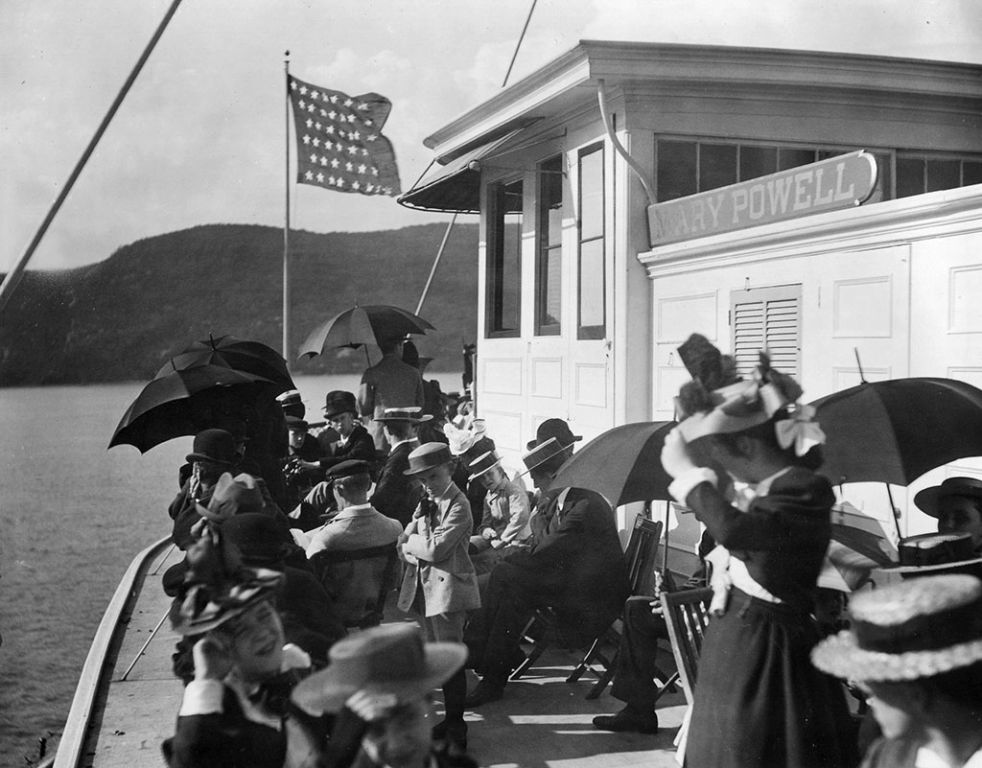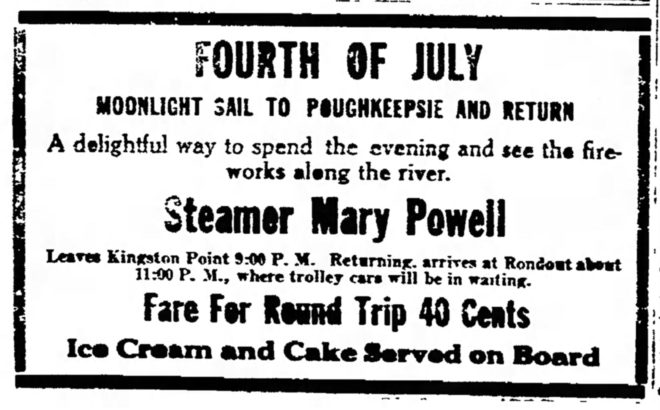
by Sara Wassberg-Johnson, Hudson River Maritime Museum
The Fourth of July is the celebration of the Declaration of Independence, when thirteen colonies asserted their right to self-rule. Six years of war ensued, but in the end the new United States were victorious. Throughout the 19th century, Independence Day was celebrated as a unifying national holiday, even as the original thirteen states expanded to include all of the territory between two oceans. But like the war that followed the Declaration, the ensuing years were not without problems, problems which were often at odds with the freedoms espoused by the Declaration. Slavery, immigration, Indian Removal, and the struggle for women’s rights all marked the first 60-odd years of American history. In Rochester, NY on July 5, 1852, Frederick Douglass’ scathing speech, “What, to a slave, is the Fourth of July?” illustrated many of the divisions present in our new nation.
The steamboat Mary Powell, called “Queen of the Hudson” from her launching in 1861, held many Fourth of July excursions over the years, with a schedule sometimes as long as 6:00 a.m. to 11:00 p.m. But one of her first Independence Day excursions was held on July 4, 1863. Unlike excursions in later years which focused on the celebrations and fireworks at Kingston Point Park, this advertisement, published in the New York Observer on July 2, 1863, focused on a daytime sightseeing cruise around Staten Island and New York Harbor. Mary Powell departed New York City for Kingston at “3 ½ o’clock,” missing the fireworks held in New York City that evening.
It was the middle of the American Civil War, and, unbeknownst to most Americans, July 4, 1863 would become a major turning point of the war. On that day, Confederate General Robert E. Lee and the Army of Northern Virginia were resoundingly defeated at Gettysburg, Virginia. At the same time, General Ulysses S. Grant’s six month siege of Vicksburg, Mississippi was finally broken on July 4 with the surrender of the starving Confederates.
These two victories were celebrated throughout the Northern states. On July 6, 1863, the New York Herald reported, “The great and glorious victory won the eve of the Fourth of July by our heroic Army of the Potomac has, we verily believe, settled the fate of the rebellion.” But it was not to be. Determined to hold on until the Presidential election of 1864, in hopes that Lincoln would be defeated and non-abolitionist Northerners would capitulate, the Confederacy fought on.
In New York City, which was largely pro-slavery in stark contrast to abolitionist Western New York, the first weeks of July, 1863 brought the Draft Riots. A new mandatory conscription law had been passed making every male citizen between the ages of 20 and 35, and every unmarried man between the ages of 35 and 45 eligible for conscription. Black Americans were not considered citizens, and therefore were not eligible for the draft. In addition, wealthy men could buy their way out of the lottery, avoiding conscription with a fee that equaled a year’s wages for the average laborer.
After the first draft lottery on July 11, 1863, tensions over the draft exploded. On July 13, thousands of White men, mostly Irish immigrants, attacked first government buildings, and later Black residents, including setting fire to the Colored Orphans Asylum. White dockworkers, including the Longshoremen Association, attacked waterfront businesses that catered to Black workers, attempting to drive Blacks out of the workforce altogether. Symbols of Black economic success and White abolitionists or sympathizers were also attacked. Black men in particular were lynched or beaten to death throughout the city. The official death toll was 119 people, although some historians estimate it may have been as high as 1,200. It took the intervention of New York regiments of federal troops, fresh off the Battle of Gettysburg, to quell the riots.
In just four days, White rioters had destroyed millions of dollars of property and left some 3,000 Black residents homeless. Between 1860 and 1865, New York City lost a quarter of its Black population.
1863 is also the year Captain Absalom Anderson added the “Goddess of Liberty” figurehead to the top of the Mary Powell’s pilot house. Representing Columbia, the personification of the United States, it’s difficult to say what she meant to Anderson. Did he have abolitionist sympathies? Was it a statement about maintaining the Union? We may never know. In 1864, the Mary Powell offered another excursion to New York City, and the Poughkeepsie Eagle News reported that her excursion around Staten Island was “the excursion of the day.”
In 1865, the assassination of President Lincoln just days after the end of the war with the surrender at Appomattox shocked the nation, but also derailed Lincoln’s efforts at Reconstruction. In 1865, the Mary Powell was sold to Thomas Cornell and although we can find no mention of a Fourth of July excursion that year, the advertisements resumed in 1866 and the trips seemed to continue throughout her career, with the last occurring in 1916. The Mary Powell’s last season of service was 1917, and her career, which had started with the Civil War in 1861, ended with the U.S. entrance into the First World War. Although the Mary Powell saw a period of incredible change in American life, one constant sadly remained. Like their grandfathers who had served the Union Army, Black troops returning from the First World War still faced discrimination and violence. And, like with the Draft Riots of 1863, White laborers still feared Black economic success. Summer, 1919 became “Red Summer” for its succession of race riots, including in New York City in July, 1919.
As it has since the beginning, the Fourth of July, American Independence Day has represented many different things to many different people. And, since the beginning, freedom has not always been accorded equally. But on this day we can look to the higher ideals and strive to form “a more perfect union,” one that truly affords everyone “life, liberty, and the pursuit of happiness.”
by Sarah Wassberg-Johnson, Hudson River Maritime Museum
